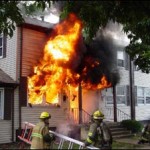Leading Causes of Residential Fire Fatalities: Unintentional/Careless Actions, Smoking
By Christopher J. Naum, SFPE on Mar 23, 2012 with Comments 0
USFA Releases Civilian Fire Fatalities in Residential Buildings (2008-2010) Report “Other unintentionally set, careless” actions and “smoking” are the leading causes
 The Federal Emergency Management Agency’s (FEMA) United States Fire Administration (USFA) issued a special report today examining the characteristics of civilian fire fatalities in residential buildings. The report, Civilian Fire Fatalities in Residential Buildings (2008-2010) was developed by USFA’s National Fire Data Center and is based on 2008 to 2010 data from the National Fire Incident Reporting System (NFIRS).
The Federal Emergency Management Agency’s (FEMA) United States Fire Administration (USFA) issued a special report today examining the characteristics of civilian fire fatalities in residential buildings. The report, Civilian Fire Fatalities in Residential Buildings (2008-2010) was developed by USFA’s National Fire Data Center and is based on 2008 to 2010 data from the National Fire Incident Reporting System (NFIRS).
According to the report:
- Ninety-two percent of all civilian fatalities in residential building fires involve thermal burns and smoke inhalation.
- The leading specific location where civilian fire fatalities occur in residential buildings is the bedroom (55 percent).
- Fifty percent of civilian fire fatalities in residential buildings occur between the hours of 10 p.m. and 6 a.m. This period also accounts for 47 percent of fatal fires.
- Thirty-six percent of fire victims in residential buildings were trying to escape at the time of their deaths; an additional 35 percent were sleeping.
- “Other unintentionally set, careless” actions and “smoking” (each accounting for 16 percent) are the leading causes of fatal residential building fires.
- Approximately 44 percent of civilian fatalities in residential building fires are between the ages of 40 and 69.
- Thirteen percent of the fire fatalities in residential buildings were less than 10 years old.
Civilian Fire Fatalities in Residential Buildings (2008-2010) is part of the Topical Fire Report Series. Topical reports explore facets of the U.S. fire problem as depicted through data collected in NFIRS.
Each topical report briefly addresses the nature of the specific fire or fire-related topic, highlights important findings from the data, and may suggest other resources to consider for further information. Also included are recent examples of fire incidents that demonstrate some of the issues addressed in the report or that put the report topic in context.
REPORT DOWNLOAD: Civilian Fire Fatalities in Residential Buildings (2008-2010)
News and Features
- Civilian Fire Fatalities in Residential Buildings (2008-2010)
- USFA Releases 2010 Fire Estimates
- Trends in Fire Death Rates: 2004-2008
Residential Fire Trends
 Click charts below to enlarge.
Click charts below to enlarge.
2008 State Fire Death Rates
| State | Fire Death Rate |
|---|---|
| District of Columbia | 32.2 |
| Oklahoma | 26.4 |
| Arkansas | 24.1 |
| West Virginia | 23.7 |
| Alabama | 22.5 |
| Mississippi | 22.5 |
| Tennessee | 22.0 |
| Louisiana | 21.4 |
| South Carolina | 18.7 |
| Alaska | 17.5 |
Fire Statistics
Fire in the United States
This report provides a statistical overview of fires in the United States and is designed to equip the fire service and others with information that motivates corrective action, sets priorities, targets specific fire programs, serves as a model for State and local analyses of fire data, and provides a baseline for evaluating programs.
 Fire in the United States Fifteenth Edition (2003-2007) (PDF, 5 Mb)
Fire in the United States Fifteenth Edition (2003-2007) (PDF, 5 Mb)
14th Edition (PDF, 4.1 Mb)
13th Edition (PDF, 1.3 Mb)
12th Edition (PDF, 2.3 Mb)
11th Edition (PDF, 1.7 Mb)
10th Edition (PDF, 2.0 Mb)
9th Edition (PDF, 3.7 Mb)
 Profile of Fire in the United States Fifteenth Edition (2003-2007) (PDF, 1.3 Mb)
Profile of Fire in the United States Fifteenth Edition (2003-2007) (PDF, 1.3 Mb)
Filed Under: Featured • Research • Research Hub • Statistics & Data
































